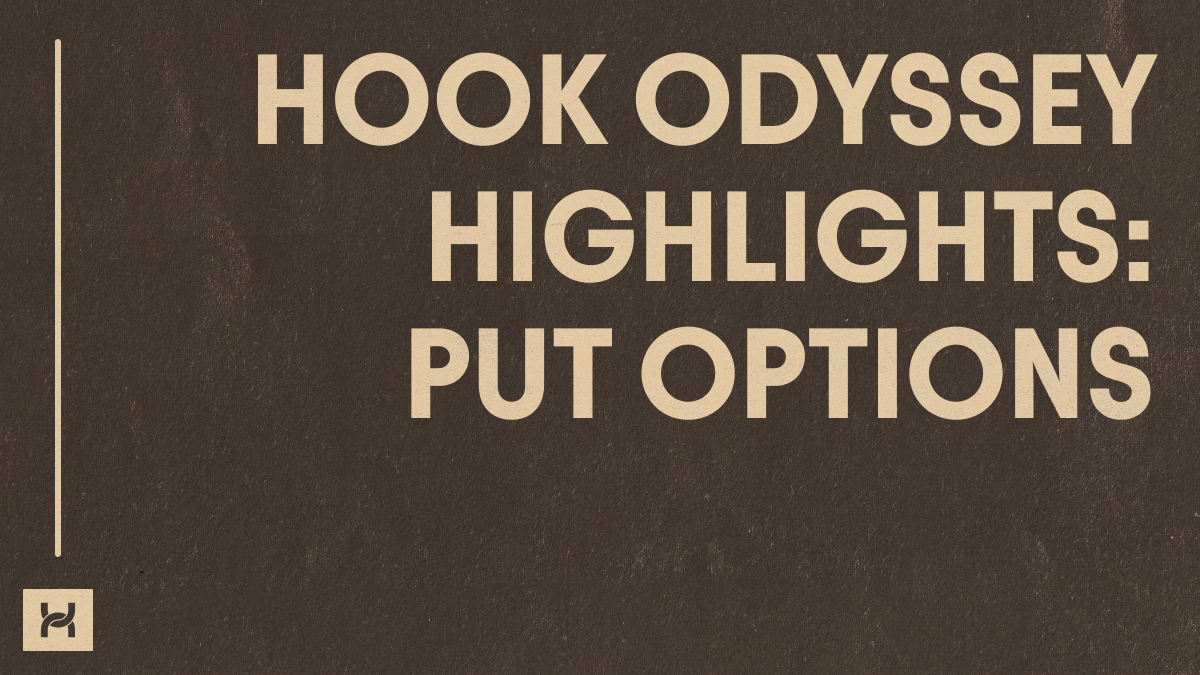Hook Odyssey Highlights: Put Options

We recently shared a preview of the next iteration of Hook, which will be called Odyssey. Over the next few weeks, we’ll dive into Odyssey’s new features – starting with shorting collections.
Since Hook’s launch, our team has focused on building the best possible NFT call options protocol. Hook has created new functionality for NFTs like the ability to earn upfront ETH on them and the ability to speculate at a fraction of the cost with fixed downside. Traders have used Hook to generate 10,000%+ returns and holders have consistently earned ETH with NFTs that would otherwise be idle in their wallets.
While Hook’s call options have brought numerous benefits to NFTs, shorting NFTs using put options is one of our most frequent customer requests.
Fortunately, those looking to short will not have to wait much longer as Hook Odyssey, our upcoming protocol upgrade, has first-class support for put options. Traders will finally be able to short NFTs and hedge other NFT finance positions like AMM LPs and Loans.
Why Puts Didn’t Make Sense Before
NFT put options have existed for as long as call options, yet the existing cash-secured puts have not become popular. So, why have they never caught on, and what are we doing to make Odyssey’s put options more exciting?
Preexisting NFT put option products are fully collateralized, meaning a writer needs to deposit the strike price into the put contract until the expiration date. Put buyers end up paying writers not only for the risk of the NFT floor declining but also for the cost of capital that ends up locked in the contract.
Odyssey’s put options are partially collateralized – based on its internal margin system. This means that writers can write and hedge options much more capital efficiently, and options buyers can short through puts that cost less than half the amount of the current fully-collateralized positions.
This reduction in costs makes use cases possible that were simply non-economical before. Partial collateralization also increases the number of puts that may be written in a market because, given the same amount of collateral, a trader could write multiples of the number of puts.
Example: Fully Collateralized Put Options
In this example, we’ll discuss how a trader could short a high-floor collection like Cryptopunks with a fully collateralized put option.
Floor Price: 47.5 ETH
Strike Price: 38 ETH (20% OTM)
Expiration: 90 Days
Floor Price on Expiration: 35 ETH
Premium: 1.01 ETH
To short a Cryptopunk, the option writer would deposit 38 ETH (the strike price) into the contract to guarantee to the buyer that their option can be exercised. If the floor price dropped to 35 ETH on the expiration date, the option would settle in the money and the buyer would profit 3 ETH.
Synthetic Cash-Settled Put Options
With synthetic put options, the trader selling the put option does not need to deposit the entire strike price for the trade to occur. Instead, Odyssey’s margin system, which we'll share more about in the future, allows them to deposit only a fraction of the strike price, depending on the current market conditions.
If the option settles in the money, the spread amount (floor price - strike price) will automatically be transferred to the buyer. In this case, the option writer would only need to deposit 9.5 ETH into the protocol instead of 38 ETH for the trade to work. The writer could also use that balance as a margin for other positions, however, they can be liquidated if the margin falls below a certain amount.
What’s Next?
Hook Odyssey’s new architecture creates a new, capital-efficient way to short NFT collections. This will enable shorting, more complex hedging strategies, and more that will allow the NFT market to scale. We’re excited to dive into some of these strategies in the coming weeks.
